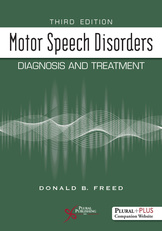Publication
Motor Speech Disorders
Diagnosis and Treatment
- Third Edition
- Details:
- 373 pages, Color Illustrations (4 Color), Softcover, 7 x 10"
- Included Media:
- Companion Website
- ISBN13:
- 978-1-63550-095-0
- Release Date:
- 08/01/2018
Overview
Includes 2 hours of clinical videos!
Motor Speech Disorders: Diagnosis and Treatment, Third Edition offers a detailed yet streamlined introduction to motor speech disorders for graduate students and beginning clinicians. The text offers a brief historical overview of motor speech disorders, providing useful context for understanding the technology and methodology used by modern speech-language pathologists for evaluation and treatment. The text also provides a practical introduction to the human motor system and detailed coverage of six pure dysarthrias, mixed dysarthria, and apraxia of speech.
Key Features:
- Chapter outlines identify the major topics discussed in each chapter
- A concise summary effectively wraps up each chapter to emphasize key points for students
- End-of-chapter study questions prompt review and application of topics discussed in each chapter
- Bolded key terms throughout and an end-of-book glossary
- Videos of real life cases studies featuring patients with motor speech disorders
New to the Third Edition:
- Updated chapters with the latest research on motor speech disorders, with particular attention to new studies of treatment procedures
- Now with full-color illustrations, providing significantly better visualization and understanding of neuroanatomy
- New 7" x 10" trim size
- Access to a PluralPlus companion website with upgraded clinical case videos (especially those on apraxia of speech) and PowerPoint lecture slides, and an image bank
Review
Kendrea Layne Garand, PhD, CScD, (University of South Alabama), Doody's (October 2018):
"**Description** This book thoroughly reviews the two major types of motor speech disorders: dysarthrias and apraxia of speech. Each chapter is organized similarly, following a logical flow of introduction, neurological etiologies, deviant speech characteristics commonly present, treatment suggestions, a summary, and questions to enhance student learning. An additional chapter is dedicated solely to assessment, with a template for immediate clinical translation. The online resources give clinical examples of each type of motor speech disorder and include PowerPoints that highlight salient points from each chapter. The previous edition was published in 2011 by Cengage Learning. **Purpose** The purpose is to present assessment and management information related to motor speech disorders. The book accomplishes this well with an easy-to-read writing style, relevant clinical written and video examples, and organized chapters that enable readers to know what to expect as they move through each disorder type. The revisions in this edition focus on updated color illustrations and updated treatment procedures. **Audience** The target audience is students and novice clinicians interested in learning about motor speech disorders. The author uses his own clinical experience to provide real-world examples. He is considered an expert in this area and has authored the two previous editions, as well scholarly journal publications on neurogenic communication disorders, including motor speech disorders. **Features** Since this is meant to be an introductory book, it lacks in-depth detail of various etiologies, differential diagnosis, and management techniques seen in other books. For example, it is missing a discussion of using instrumentation both during the assessment and management phases, but it does a good job fulfilling its purpose as an introductory book. Each chapter on the various disorder types follows a consistent organization, ending with a summary and questions for learning reflection. References, a glossary, and an index end the textbook. The color illustrations add value for learning. I commend the author on the easy-to-read format, not a small feat for such a complex topic. **Assessment** ... this book meets the purpose of providing an introduction to the subject. Its clinical usefulness to students and novice clinicians is demonstrated by its assessment template for immediate use in the clinic, as well as the online videos and case examples that allow them to observe real-life clinic patients to help train their ears to aid in differential diagnosis. This update is needed in this rapidly changing field as new evidence continues to emerge. 4 STARS!"
Preface
About the Author
Chapter 1. A Brief Historical Review of Motor Speech Disorders
Chapter 2. The Motor System
Chapter 3. Evaluation of Motor Speech Disorders
Chapter 4. Flaccid Dysarthria
Chapter 5. Spastic Dysarthria
Chapter 6. Unilateral Upper Motor Neuron Dysarthria
Chapter 7. Ataxic Dysarthria
Chapter 8. Hypokinetic Dysarthria
Chapter 9. Hyperkinetic Dysarthria
Chapter 10. Mixed Dysarthria
Chapter 11. Apraxia of Speech
References
Glossary
Index
About The Author
Donald B. Freed, PhD, is a professor in the Department of Communicative Disorders and Deaf Studies at California State University, Fresno. He received his MS and PhD from the University of Oregon. Prior to his PhD, he worked as a speech-language pathologist in acute care and rehabilitative medical facilities. He also worked as a research speech pathologist for three years at the Portland VA Medical Center. His research has primarily concentrated on adult language and motor speech disorders.
Related Titles
Here's How to Treat Childhood Apraxia of Speech
446 pages, Illustrated (B/W), Softcover, 8.5 x 11"
Cognitive Rehabilitation Therapy for Traumatic Brain Injury
321 pages, Illustrated (B/W), Softcover, 7 x 10"
Neuroscience Fundamentals for Communication Sciences and Disorders
700 pages, Color Illustrations (4 Color), Hardcover, 8.5 x 11"
The Right Hemisphere and Disorders of Cognition and Communication
301 pages, Illustrated (B/W), Softcover, 7 x 10"
Neuroanatomy and Neurophysiology for Speech and Hearing Sciences
J Anthony Seikel, Kostas Konstantopoulos, David G. Drumright
385 pages, Color Illustrations (4 Color), Hardcover, 8.5 x 11"
Movement Disorders in Neurologic Disease
Leonard L. LaPointe, Bruce E. Murdoch
232 pages, Illustrated (B/W), Softcover, 7 x 10"
Assessment of Motor Speech Disorders
Edited by: Anja Lowit, Raymond D. Kent
371 pages, B/W With Color Insert, Softcover, 7 x 10"
Purchasers of this book receive complimentary access to supplementary materials hosted on a PluralPlus companion website.
To access the materials, log in to the website using the URL and Access Code located inside the front cover of your copy of Motor Speech Disorders: Diagnosis and Treatment, Third Edition.

















